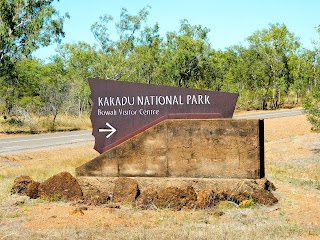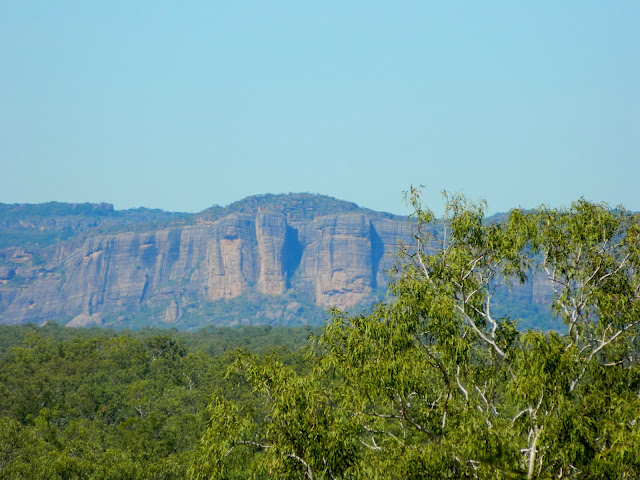With the Queen’s Birthday long weekend coming up,
Vic took Friday off, and we headed out to Kakadu National Park for the four
days. Our good friends, Neil and Jan, who arrived on Wednesday, accompanied us.
They had hired a camper van (better known in caravan circles as a ‘Slammer’ or
a ‘Whiz Bang’) and were staying around Kakadu for a week or so. I’d decided
(much to Vic’s disgust!) to leave the van at home and use the tent this
weekend.
We dropped Flash at the Pet Resort on the way out, and
just down the road from there, turned onto the Arnhem Highway. About 96 klms up
the road, we stopped at the Mary River Park and purchased our Kakadu Park Pass
($25 / person gives access to the park for 14 days) before stopping again, just
up the road, at the Bark Hut Inn, where we had morning tea. There’s a nice
caravan park behind the pub and I reckon it’d be a top spot to stay a night and
have a couple of cold drinks, at the bar, with the locals.
About 170 klms from Darwin, we entered the Kakadu
National Park, and I was excited to, finally, be ticking this box on my bucket
list.
When visiting Kakadu, the Aboriginal traditional owners encourage you, to
take the time to look, listen and feel the country, and to experience the true
essence of the land.
 |
| Merl campground |
At 261 klms we took the turn toward Ubirr
(pronounced Oo-beerr) Rock, and travelled the 36 klms to Merl Campground. We
chose our spot from the many shaded and private areas available and set up camp.
 |
| Cahills Crossing |
After a bite to eat we drove the short distance to Cahills Crossing where it is possible
(with a permit) to cross the East Alligator River into Arnhem Land.
 This is where salt meets fresh water, and as the
tide rises and falls, the crossing becomes very dangerous and has claimed quite
a few vehicles in the past.
This is where salt meets fresh water, and as the
tide rises and falls, the crossing becomes very dangerous and has claimed quite
a few vehicles in the past.
While here, we watched a fisherman
pull in a nice barramundi that was undersized. Didn’t matter to him that it had
to go back though… he didn’t eat fish!
The river here, as with the entire park, is populated by crocs, and on a bush walk just downstream, we spotted a 2 – 3 metre crocodile sunning itself on the bank.
 |
| No swimming here |
 |
| East Aligator River at Cahills Crossing |
 |
| Sunning crocodile on the opposite back |
Late in the afternoon, we made our way to the Ubirr
Rock car park and grabbed the camera, camcorder and water bottles. We took the 1 km circuit that leads past some
fascinating Aboriginal rock art sites, some of which are up to 20,000 years
old.
 |
| Heading off to Ubirr Rock |
We climbed Ubirr Rock and took our spot on Nadab
Lookout, overlooking the East Alligator River wetlands. This is where Mick
‘Crocodile’ Dundee said, “This is my backyard”. From here we watched the
birdlife below, as it prepared to settle for the night, and waited for the sun
to set. This was probably the thing I wanted to do most while in the Northern
Territory, and sitting up here with Vic, Neil and Jan, was everything I’d
expected. I was in awe. Yes, the sunset was glorious, and the scenery
absolutely spectacular, but I’ve seen other glorious sunsets and spectacular
scenery since leaving Brisbane. But this was Ubirr… probably the most iconic
landmark in the 20,000 square kilometres that make up Kakadu National Park.
 |
| Across the wetlands at Ubirr Rock |
 |
| The rock formation was fabulous |
With Kakadu you have to experience it to really appreciate the vast open plains, rocky outcrops and flora. Then there's the sunsets...
 |
| Our spectacular sunset from on top of Ubirr Rock |
 |
| Yep even Gnome made it to Ubirr |
 |
| Vic's little ray of sunshine |
 |
| As the sun fell the scenery colours were amazing |
Back at camp, we paid the Ranger our camping fee
($10 each), then had a couple of cold drinks while getting dinner ready and
calling it an early night. As we originally packed for this trip, I had checked
the condition of all the camping gear before it went into the caravan and the airbed
passed ok… but by morning here in Kakadu, it was flat! The next two nights
should be fun!
 |
Couldn't take photos here :(
but it was really interesting. |
Saturday, we woke early and broke camp before
continuing our trip into Jabiru. On the way we visited the Bowali Visitor
Centre, one of two visitor centres in the park. Here, you’ll learn about the
geographical aspects of Kakadu, it’s plants and animals and it’s people. You’ll
also learn about the steps being taken, by the Bininj and Mungguy people
(traditional owners) along with Parks Australia, to protect this World Heritage
area. An Aboriginal rock shelter inspired the centre’s building.
 In Jabiru, we got some supplies from the
supermarket, and were surprised by the reasonable prices, considering the
remoteness of the town. There is a nice picnic area by the lake, so we decided
to have our lunch here.
In Jabiru, we got some supplies from the
supermarket, and were surprised by the reasonable prices, considering the
remoteness of the town. There is a nice picnic area by the lake, so we decided
to have our lunch here.
Back on the road, we headed southwest toward the
campground at Mardugal, where we intended to spend the next two nights. Along
the way, we crossed the billabong on Burdulba Creek, and Vic spotted a family
of Jabiru (Black-Necked Stork) wading in the shallows. We pulled up and spent
some time watching (and photographing) the pair and their juvenile, as they
searched for a meal of fish or frogs. At the time it seemed a bit silly,
standing on the bridge, watching the Jabiru, along with Brolgas, Waterfowl and
Egrets, in this small wetland. In hindsight though, I’m glad we did, because
these were the only Jabiru we saw all weekend.
 |
| A pair of Jabiru (the female has the yellow eye) |
Down the road a little, we turned into Mardugal,
and once again, picked our spot and set camp. Now, if you think Vic wasn’t
happy with me about leaving the van in Darwin and having to sleep on a
deflating air mattress, you’d be spot on! Neil came to the rescue though, by
loaning us the folding mattress out of the whiz-bang. (and I got to sleep in
the tent, not out in the open, as my fate may have been J)
Just before dark, the Ranger came around and
collected our fees ($10 each again), and sat for a while to talk. He’s actually
a retired Park Ranger who lives in NSW. He tendered for the position, and will
come up here each season for the next five years, live on site in a caravan and
look after the camping area. His wife suggested he apply for the job and stayed
at home when he got it. Maybe his retirement affected her more than him!
That night, we attended a slide presentation that
was held in the campground, dealing with the park’s birdlife.
............check out part B of our Kakadu trip this week in the next post.




































































